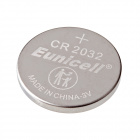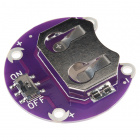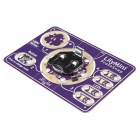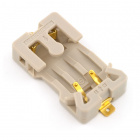LilyPad Basics: Powering Your Project
Power Options: Coin Cell Batteries
The LilyPad system includes boards that hold a single 3V CR2032 coin cell battery. These batteries are typically single use, but some rechargeable coin cell batteries may work in the holders.
- C designates a lithium battery type
- R designates a ROUND (cylindrical) battery shape
- 20 specifies the package size (diameter) in mm
- 32 specifies the height in mm. Note this is 3.2 mm NOT 32mm
The LilyPad product line includes a standalone battery holder with a switch that can be connected to a customized project, as well as built into the LilyMini board, and available in some ProtoSnap products. SparkFun also carries a non-LilyPad coin cell battery holder without sew tabs for projects that need a small footprint or for users who want to solder.
LilyTwinkle ProtoSnap
DEV-11590This depends on the LilyPad board you are powering. Two 3V batteries in series will supply 6V - some LilyPad boards do not have onboard regulation circuits and can be damaged by supplying them with more than 3V. For example, the LilyTiny and LilyTwinkle boards operate best between 2.4 and 5.5V. In these cases, a Lithium Ion/Lithium Polymer battery may be a better choice for your project.
Check out the Calculating Power Needs section for more tips on selecting the right battery for your project's unique needs.
Battery Safety and Care
This section will cover tips for safe handling and use of coin cell batteries for your projects.
Storage
Do not transport or store a coin cell battery with metal objects, such as hairpins, necklaces, or any other conductive object or material. Do not store loose coin cell batteries together - they can make contact with each other and short circuit and discharge.
Keep or store the battery in a cool and dry place/environment while installed in a project or in storage. If you are not planning to use your project for a long time, remove the battery and store it separately.
Keep Away from Heat and Moisture
Keep your coin cell battery away from environments that will damage it. Do not immerse a coin cell battery in liquids. Remove the battery from your project if it needs to be washed.
Do not use or store the battery near any source of heat. To secure a battery to your project, use a specialty battery holder, sewn pouch, or place in a plastic enclosure. Never solder directly to a coin cell battery; if you need to solder one into a project, use a special battery holder or purchase a battery with solder tabs created for this purpose.
Inspect Battery Before Each Use
Short circuits or damage to coin cell batteries may not always be noticeable - check the battery for puffiness, heat, or other changes. If the battery looks damaged, remove immediately.
If the battery gives off an odor, generates heat, becomes discolored or deformed, or in any way appears abnormal during use, recharging, or storage, immediately remove it from your project or battery charger and stop using it. Make sure to dispose of your batteries properly - do not throw them in the trash! Contact your local e-waste disposal organization for details on how to discard batteries in your area.




